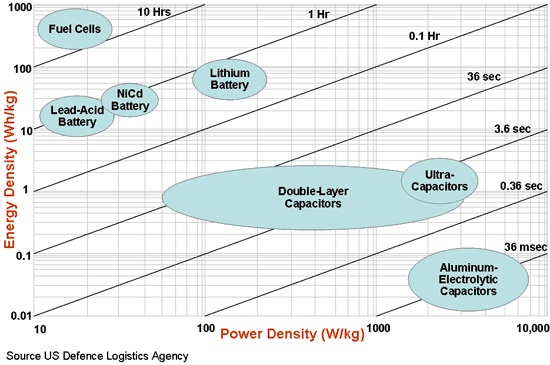WhiteBlue wrote:
You need to understand that the parallel concept avoid discharging the battery between 10% and 90%. By coupling three series of cells in parallel you deplete the combined cells only by a third of 80%. It means you will only take a third of the time to charge them back to full 90% capacity. Effectively you only skim the top of the capacity and carry the rest around. It is a big waste but the only way you can go if your charge/discharge rate isn't high enough.
Principally adding serial cells builds voltage and adding parallel cells builds current. To build power you multiply current and voltage. This why the weight increases so rapidly. The only way to improve is having chemical systems that run higher voltage at higher or equal current. The current chemistry is temperature restricted at 60°C. If they find a reaction that tolerates higher temps at equal thermal efficiency and heat conduction they can create a bigger heat flow and from the driving temperature difference and also bigger charging power.
Thanks for your nice little lecture WB, I´m qite familar with the basic concept of serial and parallel combinations of accus/batteries as well as with the concept of P=U*I and R=U/I. But I truly appriciate your effort - thank you.
As far as I can tell you found a way to harvest 1 MJ or 100kW with your system during a 10 sec period.
Did our aim was not to harvest 4MJ or at least 333kW (3.3 MJ) during a lap?
You "pay" around 150 kg (very conservative estimate) for your 100kW advantage.
If we you can still built a car at let´s say 640Kg minimum weight that means you have a power to weight ratio of 450kW + 100kW = 550kW/640Kg = ~0,86kW/kg.
If the FIA would not be so narrow minded and allow free competition I would go with a 450kW engine and 490kg weight (fuel weight will come on top in both cases + 100kg) and arrive at a power to weight ratio of ~0,92kW/kg.
Given that we both would have the same amount of downforce and the same tire, I would know which solution is more "efficient" in my book, and which one I would choose any given day.
Both cars would have the same (lower)fuel consumption.
Sorry, but without the artificial concept of minimum weight, I fail to see the advantge in your KERS proposal.
Czapski Renault F1 team about the 2009 KERS wrote:
It’s a very good question because every 10 kilograms of excess
weight in a Formula One car means it is 3/10ths of a lap slower.
KERS as it stands is about 3/10ths of a lap quicker with the current regulations so
you can see if we go overweight by 10 kilos we’ve lost it.
Yes, you "recover" energy which you then need to spend/use to accelerate a much heavier car to the same speed, so that you can "recover/harvest" your energy again.
This maybe is efficient, but it is not very effective IMHO.
By the way.
I do understand your concept as I said you carry a lot of unused battery capacity all the time.
Did this mean, you are allowed to start your race with a fully charged KERS battery (making a F1 car a plug in Hybrid), or does it mean you need 25 laps before your battery is fully charged, and then you can use your proposed charge/discharge cycle?
As for the proposed, and in your point of view o.k., lifespan of 2 batteries per engine or ~ 10 batteries per season and car.
What´s the price of such a battery? (somewhere in the internet 70.000$ was mentioned for a 2009 F1 battery)
If we take this value, that would make 2 (cars) x 10 (batteries/year) x 70 000$ = 1.4 Million$ per team and year.
Now, if we keep in mind that we would need ~ 4 x the 2009 capacity, we´re coming to a point where it doubles the proposed engine lease of 5 Mill $ per team/year.



